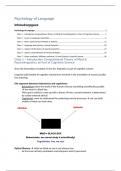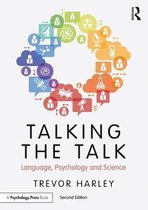Psychology of Language
Inhoudsopgave
Psychology of Language................................................................................................................................. 1
Class 1 – Introduction Computational Theory of Mind & Psycholinguistics as Part of Cognitive Science...........1
Class 2 – Issues in Language Acquisition..............................................................................................................6
Class 3 – Brain, Experimental Methods & Aphasia............................................................................................13
Class 4 – Language and Memory, Neural Networks..........................................................................................18
Class 5 – Aspects of the theory of speech production........................................................................................24
Class 6 – Speech comprehension & Parsing strategies......................................................................................30
Class 7 – Down syndrome, Williams syndrome, SLI and Dyslexia, Linguistic Savant.........................................36
Class 1 – Introduction Computational Theory of Mind &
Psycholinguistics as Part of Cognitive Science
Since the Chomskian revolution in the 50s, linguistics is part of cognitive science.
Linguists build models of cognitive mechanisms involved in the translation of sound (usually)
into meaning.
Old argument between behaviorists and cognitivists:
- Behaviorists reject the study of the human mind as something scientifically possible
the mind is a black box.
- Their goal is solely to come up with a theory of how a certain behavior is determined
by certain external stimuli.
- Cognitivists: want to understand the underlying mental processes we can build
models of what our brain does.
Optical illusions what we think we see is not always true.
- So the brain actively contributes and interprets what is perceived.
,In visual cognition, researchers build models of how to go from perception of visual stimuli
(e.g. size, distance, texture) to the interpretation of something as a particular object.
In language: from sound to meaning.
What is cognition?
- There are processes in the mind that connect us to the world.
- IMPORTANT: It is not always conscious.
Modularity there are different systems for different stimuli with their own rules (smell,
touch, sight, etc.) but they can communicate with eachother.
McGurk Effect Ba Ba Ba, sounds like Va Va Va when they change the mouth movement.
Demonstrates that different modalities (e.a. vision and language) interact with each other.
Unconsious.
EXAM QUESTION: How is the McGurk effect relevant for the modularity issue?
- It is relevant because although different modalities appear to be distinct, they do
interact with each other and can even influence the final interpretation of stimuli.
One more thing:
- We need to distinguish between language as a cultural/social phenomenon and
language as a biological phenomenon.
- Cultural/social aspect: language use
- Biological aspect: knowledge of language
SUMMARY
- Psychology of Language (or psycholinguistics) is NOT about how we use language to
interact with other people.
- It is NOT about psychology of communication.
- It is a science of what we know when we know language, and how we implement this
unconscious knowledge in real time.
Knowledge of Language the main idea: Language Faculty
- Human language capacity is a property of the brain. There are language-specific rules
that are instantiated in certain areas of the brain.
,Which means studying language structure is:
- studying the structure of the human mind (and brain perhaps).
A very old question What is the relationship between Mind (the information itself) and
Brain (system that processes the information)?
Computational Theory of The Mind
- Comparison with Hardware and Software
- Mind: Analogous to software
- Brain: Analogous to Hardware
- To know something means to have the necessary hardware that is capable of running
a specific program (software).
- The mind is what the brain does, what the brain produces.
Three levels of understanding
1. Computations Formal, symbolic operations performed independently of the
context. Example: 3 apples + 2 apples = 5 apples. But for oranges it’s the same
because there is a rule.
2. Algorithm How the computation is carried out, possible in many ways.
3. Implementation by what means the system does the computation
In order to understand a certain phenomenon, we need to know:
• WHAT is done (computation)
• HOW it is done (algorithm)
• BY WHAT MEANS it is done (implementation)
In language research:
- WHAT (computations): theoretical linguistics
- HOW (algorithm): what happens in real time processing
- By What Means (Implementation): Patterns of neural activation? Relevant brain
structures?
The unification problem How to relate the three levels: implementation, algorithm,
computation.
Phonology
- The unit of analyses – a phoneme
- The first purely linguistic level
- The most elementary units of speech
- Distinctive phonemes: something distinguishable in a given language (c.f. ‘worm’’vs.
‘warm’), etc.
Basic building blocks of human speech; languages select what to use
Dutch: /g/ vs /h/ is distinguishable, but not in Russian
In Japanese: /l/ = /r/ (Lamp sounds like Ramp and vice versa)
, Sign languages:
- They too have phonemes!
- Naturally, they are not acoustic signals but particular shapes.
- There is such thing as a foreign accent in sign language
Phonemes are organized in a structure – and:
There are constraints on possible and impossible structures, on possible and impossible
computations.
Example:
Can there be a word in English that begins with /rt/? you feel it cannot, impossible
Can there be a word in English that has 6 consonants in a raw?
There are some universal preferences Many languages have BL combination but very few
have LB
Morphology A morpheme – the smallest meaningful unit of speech cat (free
morpheme), s (bound morpheme)
- Functional morphemes no meaning on it’s own but in combination. a, the, have,
is, -ing, -ed, -able, etc.
Sign language: also has morphemes and they are also structurally organized
Click languages: a click is a phoneme that can be also a morpheme
Tonal languages: a tone can be a morpheme
Syntax Unit of analyses: a phrase, how a phrase is organized.
- Phrases are organized hierarchically
- Rules of syntactic computations are followed unconsciously by native speakers:
- The man left *Left the man
Both in production and comprehension we know and we are implementing some linguistic
rules
• we do it fast, automatically, unconsciously
• we don’t break these rules (putting aside occasional speech errors)
Psycholinguistics is a science that builds models of these rules and their implementation.
- It is a science that strives to uncover the unconscious properties of the mind.
- It is also a science about where this knowledge comes from (next class: language
acquisition)
Do not confuse language and communication!
• Language is a biological property of the human (and only human!) brain
• It can be used for communication
Other animals, too, can communicate (bees, dolphins, monkeys, birds, etc.)






